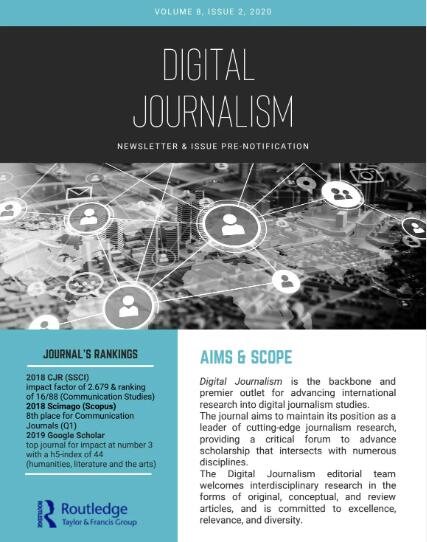“Find the Joy”: A War Correspondent’s Tweets and the Rise of an Affective Age in News
IF 5.2
1区 文学
Q1 COMMUNICATION
引用次数: 0
Abstract
AbstractThis study provides empirical support for undertheorized phenomena in contemporary digital news reporting—the foregrounding of joy-based news values and the presentation of affective, immanent atmospheres—as they manifest in U.S. National Public Radio correspondent Tim Mak’s daily Twitter threads from the 2022 Russian invasion of Ukraine. Multimodal textual analysis of 647 tweets over 31 threads shows how affordances of newer media platforms facilitate a shift toward affective, immanent, and engaged journalism that blends traditional news style and judgment seamlessly with personal observations, contextual curation, stream-of-consciousness detail selection, and audience interaction to produce a kind of hybrid journalism that might foreshadow a transformation not just in reporters’ interaction with audiences, but also in an undertheorized reorientation to news itself.Keywords: Affectimmanencejoymultimodal analysisnews valuesnon-representational theorytextual analysisTwitter Disclosure StatementNo potential conflict of interest was reported by the author(s).Notes1 Mak later returned for additional reporting.2 An anonymous reviewer has pointed out that, after this paper was submitted, the Dalai Lama encouraged a child during a public ceremony to “suck my tongue,” an act that has been variably characterized as a case of abuse or a cultural misunderstanding (Pundir Citation2023). This puts the researcher in a difficult yet familiar position, as many people whom scholars have cited through the ages have engaged in controversial or reprehensible behavior. I present the intellectual framework of joy here independently of the Lama’s recent actions and their interpretations.3 Twitter was purchased by billionaire iconoclast Elon Musk in October 2022, throwing the platform into chaos. While its fundamental affordances remain basically intact as of this writing, the site is regressing in numerous ways and is now apparently called X.4 All tweets are quoted as best as possible exactly according to the spelling, abbreviations, and punctuation Mak used. Line breaks are occasionally, but not always, preserved to reproduce specific formal effects.《寻找快乐》:一位战地记者的推文与新闻情感时代的兴起
摘要本研究为当代数字新闻报道中理论化不足的现象提供了实证支持——以快乐为基础的新闻价值观的前景和情感、内在氛围的呈现——正如美国国家公共广播电台记者蒂姆·马克(Tim Mak)从2022年俄罗斯入侵乌克兰的每日推特帖子中所体现的那样。对31条线上647条推文的多模态文本分析显示,新媒体平台的功能如何促进向情感、内在和参与式新闻的转变,将传统的新闻风格和判断与个人观察、语境管理、意识流细节选择和受众互动无缝融合,从而产生一种混合新闻,这可能预示着一种转变,不仅仅是记者与受众的互动,但同时也是对新闻本身的一种不太理论化的重新定位。关键词:情感表现、多模态分析、新闻价值、非代表性理论、文本分析、twitter披露声明作者未发现潜在的利益冲突。注1麦后来返回作进一步报告一位匿名评论者指出,在这篇论文提交后,达赖喇嘛在一个公共仪式上鼓励一个孩子“吮吸我的舌头”,这种行为被不同地描述为虐待或文化误解(Pundir Citation2023)。这让研究人员陷入了一个既困难又熟悉的境地,因为古来学者们引用的许多人都从事了有争议或应受谴责的行为。我在这里呈现的是独立于喇嘛最近的行为和他们的解释的快乐的知识框架2022年10月,打破传统的亿万富翁埃隆·马斯克(Elon Musk)收购了Twitter,令该平台陷入混乱。虽然它的基本功能在撰写本文时基本保持不变,但该网站正在以多种方式进行回归,现在显然被称为X.4。所有的推文都尽可能准确地根据马克使用的拼写、缩写和标点符号来引用。偶尔,但并非总是,保留换行符以再现特定的形式效果。
本文章由计算机程序翻译,如有差异,请以英文原文为准。
求助全文
约1分钟内获得全文
求助全文
来源期刊

Digital Journalism
COMMUNICATION-
CiteScore
11.20
自引率
24.10%
发文量
103
期刊介绍:
Digital Journalism provides a critical forum for scholarly discussion, analysis and responses to the wide ranging implications of digital technologies, along with economic, political and cultural developments, for the practice and study of journalism. Radical shifts in journalism are changing every aspect of the production, content and reception of news; and at a dramatic pace which has transformed ‘new media’ into ‘legacy media’ in barely a decade. These crucial changes challenge traditional assumptions in journalism practice, scholarship and education, make definitional boundaries fluid and require reassessment of even the most fundamental questions such as "What is journalism?" and "Who is a journalist?" Digital Journalism pursues a significant and exciting editorial agenda including: Digital media and the future of journalism; Social media as sources and drivers of news; The changing ‘places’ and ‘spaces’ of news production and consumption in the context of digital media; News on the move and mobile telephony; The personalisation of news; Business models for funding digital journalism in the digital economy; Developments in data journalism and data visualisation; New research methods to analyse and explore digital journalism; Hyperlocalism and new understandings of community journalism; Changing relationships between journalists, sources and audiences; Citizen and participatory journalism; Machine written news and the automation of journalism; The history and evolution of online journalism; Changing journalism ethics in a digital setting; New challenges and directions for journalism education and training; Digital journalism, protest and democracy; Journalists’ changing role perceptions; Wikileaks and novel forms of investigative journalism.
 求助内容:
求助内容: 应助结果提醒方式:
应助结果提醒方式:


